How to Prune Trees and Shrubs
Gardening Information
By Cheryl Underwood, horticulturist
Pruning is the removal of parts of a plant for a specific purpose. As gardeners, we prune for aesthetic, horticultural, and safety purposes. This article will address basic pruning of most woody plants. Pruning roses and vines can be more involved and is addressed separately.
Appropriate tools are essential to a successful pruning project. The following is a list of tools that you may need depending on the size and type of your job.
- Hand pruners (Red Butte Garden recommends using bypass pruners as opposed to anvil type)
- Loppers
- Hand saws
- Pole saws and pole loppers
- Chainsaw
- Shears
Become familiar with the proper use of your tools. Make sure that your tools are clean, sharp, in good working condition and appropriate for the task at hand. Sterilizing your tools between plants can reduce transmission of disease from one plant to another. Ethanol or isopropyl alcohol are ideal for sanitizing pruning equipment because blades can simply be wiped or dipped into the disinfectant. Both types of alcohol are commonly available.
WHY DO WE PRUNE?
Aesthetics: shape, branching, flowering
Pruning is commonly performed to shape a tree or shrub into a more visually pleasing form. Pruning is also a tool to encourage flowering woody plants to bloom.
Specialized pruning techniques may be desirable to some, such as topiary, pollarding, espalier, or bonsai. These can be effective, interesting and beautiful methods, demanding a large commitment of time and effort to create and maintain the forms and health of the plant. If this is something you are interested in, learn the proper techniques and methods to keep your plant healthy and beautiful.
Size
If a tree or shrub has outgrown, or will eventually outgrow, the space it inhabits, it may need to be pruned to stay within its space. This can be a tricky task. Pruning can cause harm to the structure, and consequently, to the health of a tree or shrub, especially if the plant is mature. Topping is an example of inappropriate pruning that damages and weakens the structure of a tree and is not recommended. This practice is commonly used to prevent trees from growing into overhead utility lines. If size reduction is necessary, there are better methods.
When planting, it is best to select a tree or shrub with a mature size that is appropriate for the space. Do your research before installation. Make sure you understand what it means when a nursery gives a mature size. Is it the ultimate size over the lifetime of the tree or shrub, or is it the size at a particular age? Knowing how fast the tree or shrub grows can help you make the right choice. Many nurseries give a 10-year size for a conifer as a point of reference. It should be emphasized that conifers will continue to grow at their stated rate for the life of the plant.
See Selecting the Right Tree for more tips.
Health of the plant
Properly pruning out dead and diseased plant material is important for maintaining a healthy plant. It may remove pathogens and pests that could further infect the plant or plants around it, and it encourages new growth.
With a knowledge of how the plant grows, proper pruning can also help create a strong, safe structure.
Safety
Trees that become diseased or damaged, including from natural breakage and poor pruning, may present safety issues to people or property. They should be assessed and properly pruned or removed as necessary to mitigate the possibility of harm.
WHEN DO WE PRUNE?
In general, perform maintenance pruning (removing live wood) when the tree or shrub is dormant, meaning not actively growing. Dormancy typically occurs in winter and ends when buds begin to swell. Pruning during dormancy also gives the plant the entirety of a growing season to begin closing and compartmentalizing the wounds. Pruning should be avoided in fall and early winter when the plant is shutting down and preparing for winter dormancy, and in the spring when the plant is beginning its active growing season. If you are unable to prune while the plant is dormant, the next best time is summer, after the new growth of spring is completed.
Some species tend to ‘bleed’ when pruned in early spring. Sap drainage is unattractive but not harmful to the tree. It can be avoided by delaying pruning until mid-summer. Research the tree you are pruning to see if there are any specific recommendations.
Removal of dying, diseased, broken, or dead branches can be performed at any time.
HOW DO WE PRUNE?
There are some general pruning guidelines that apply to most situations and genera of trees and shrubs.
- Begin with removing dead, damaged or diseased branches or stems.
- When you prune off a branch or stem, make sure you prune to just above a growth point, approximately 1/4 inch, or near the base of a branch, being careful not to damage the collar or branch bark ridge.
- Make as clean a cut as possible. This allows for better healing.
- Be aware of how much foliage and/or buds you are removing from the plant. The general recommendation is to not remove more than 25% of the total living mass. This allows the plant to recover and not become detrimentally weakened.
Deciduous Trees
Trees can be a multi-lifetime investment for your landscape and deserve the best care and maintenance you are able to provide. There are a few different types of trees to consider, generally falling into the categories of deciduous (loses leaves in the winter) or evergreen (retains leaves throughout the winter). Conifers are typically evergreen but some are deciduous and drop their needles every fall.
Deciduous Trees
When pruning a deciduous tree, the main pruning cuts used are the reduction cut and the removal cut.
Reduction cuts (also referred to as drop-crotch cuts) are typically used on younger trees to help direct growth and to reduce the size or volume of the tree. The cut should be made just above an adjacent branch whose diameter is at least one-third of the diameter of the section you are removing. This should help direct new growth, and limit epicormic growth, or water sprouts.
Topping occurs when branches are removed without any thought to their relationship to other branches, or when a cut is made above a branch that is too small (less than one-third diameter of removed branch). This is also known as a heading cut. Stubs are typically left behind, which are unattractive, may promote decay, and usually result in growth of water sprouts (photo below). Topping is an inappropriate method of pruning trees.


Growth of sprouts resulting from heading cut, also called topping.
Removal cuts remove branches at their origin and are typically used to maintain the natural form of the plant.
When removing large branches, it is very important to understand where and how the cut should be made and to always follow ‘best practices’ to ensure the cut inflicts minimal damage and allows the tree to heal. Every cut you make should employ these techniques.
- Remove as much of the branch as possible while cutting just outside of the branch bark ridge and branch collar. Avoid either leaving a branch stub or cutting flush against the joining branch or trunk. This balance will allow woundwood to form properly by avoiding damage to either the branch bark ridge, at the top of where the two branches meet, and the branch collar, typically a swollen area (not always obvious) on the bottom side of where the branches meet.
A correct cut is somewhat angled and will leave some amount of protrusion on the lower side of the branch that was cut.
- With larger, longer branches it is best practice to make a relief cut to remove most of the branch before making the final cut. This will relieve the majority of the weight off the branch to prevent it from breaking and tearing the bark and live wood through the branch collar. Start by making a notch cut at some distance from where you plan to make your final cut, on the underside of the branch, about 1/4 of the way through (or less depending on the size of the branch). This cut will help prevent the bark from splitting or tearing when you make the relief cut. Next, make the relief cut by completely removing the branch beyond the notch cut. Now locate the branch bark ridge and branch collar and make your final cut. If successful, the wound should heal well over time.

- Photo 1: Correct removal cut is outside of the branch bark ridge and collar
- photo 2: Wound resulting from correct pruning cut is round, but can be oval on older branches
- Image 3: Large branch removal
Conifer Trees
Conifer trees (typically evergreen) do not replace growth like deciduous trees. For many, the removal of live material does not result in new growth. The shape and growth can be easily damaged by pruning if you do not have the necessary information on best practices and how the specific species grow. Generally, little to no pruning is needed for a naturally shaped tree. It is recommended that you prune conifers only if absolutely necessary.
If you find that you need to prune, keep it to the minimum of what needs done for your desired goal. Are there broken, damaged or diseased branches? Is the tree impeding in the landscape? Is it getting too big? Is it misshapen? If you are pruning for health, removing dead, diseased and damaged branches can be done at any time. Best practices should be followed for this and any pruning. For large branch removal, prune as you would deciduous trees, taking into account the branch bark ridge and the branch collar.
Conifers can be placed into two groups according to their growth patterns: whorl-branching and random branching. This difference will guide the pruning methods.
1. Whorl-branched conifers include: Abies (Fir); Cedrus (Cedar); Cryptomeria; Larix (Larch); Picea (Spruce); Pinus (Pine).
These conifers branch once a year when new growth occurs in the spring. New growth comes from buds at the tips of the branches, along the branch, and at the base of new growth.
Whorl-branched conifers should not be cut back beyond where there is green growth (or beyond the last whorl) because there are no dormant buds in the old wood. If pruned back beyond this point, there will almost certainly be no regrowth on the branch and it will remain bare.
The new growing tips are called candles. You can encourage more compact, dense growth of your tree or shrub by pruning the candles. This should be done while the candles are actively growing and tender, usually mid to late spring or early summer. Removing one-third to one-half of the candle while the new growth is still tender will slow the growth of your tree or shrub. Do not cut off the central leader on a tree that forms candles or you will destroy its natural shape and weaken its structure. If there is a double leader, keep only the most upright one.
How much growth the candle produces will depend upon the growth rate of the particular species, which can vary greatly. Siberian spruce can grow up to three feet per year while some miniature conifer cultivars grow only an inch per year. It is also important to understand that conifers never stop growing. Knowing the growth rate of your specific tree or shrub is good information to have.

Prune spruce and fir back to a side bud or side branch to encourage growth of side branches.
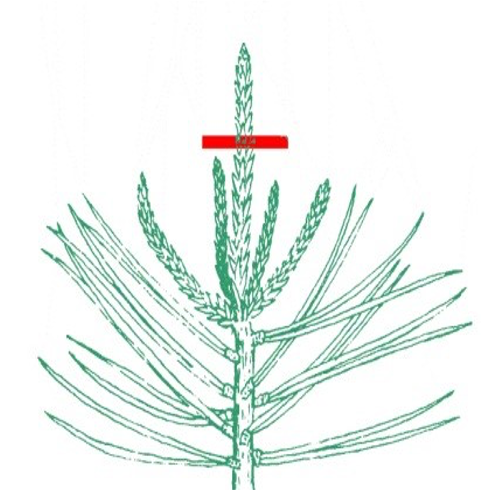
For bushier new growth on pine trees, “pinch” growing tips by snapping off one-third of the “candle” tips with fingers.
2. Random branching conifers include: Chamaecyparus (False cypress); Cupressus (Cypress); Cupressocyparis leylandii (Leyland Cypress); Tsuga (Hemlock); Juniperus (Juniper); Thuja (Arborvitae).
These conifers produce new growth from buds at the tips of the branches and buds randomly located along the stems. Foliage and dormant buds are found further back along the stem than with whorl branched species. The result is that this group can be pruned back further and still produce new growth
Pruning cuts can be made almost anywhere along the stem except into bare wood. Do not cut beyond where there is green growth and expect new growth to appear. Pruning to maintain shape is best done in early spring. Selective hand pruning rather than shearing creates a more natural shape.
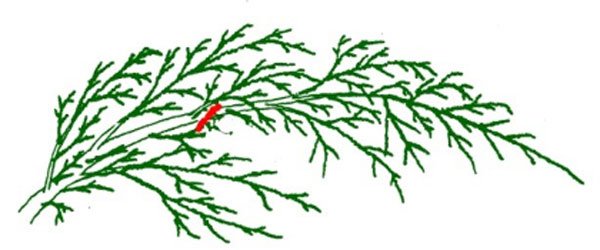
Prune junipers and arborvitae back to a side shoot.
Shrubs
Pruning shrubs involves all best pruning practices. You should work with the appropriate tools in good condition, clean, sanitized and sharp, in order to make cuts that minimize damage to the plant and opportunity for pests and disease to affect the wound.
- Learn about the specific shrub you are pruning before you begin. Different species will have different requirements, limitations and recovery. This is particularly true for rejuvenation pruning.
- Observe the entire shrub. Get a good sense of the overall shape of the plant and what you want to achieve.
- Look for damaged and diseased stems and remove them to a growing point or to the base of the stem. Make sure to remove the entirety of the damage or disease.
- When you remove a stem, make sure to prune just above a growth point, approximately 1/4 inch, or to the base of the stem.
- Remove crossing or rubbing stems to prevent damage to the stems.
- Unwanted suckering should be removed, especially if the shrub is grafted to rootstock or spreads aggressively through root suckering.
- Water sprouts are shoots that grow straight up from other branches, typically brought on by some kind of stress, and should be pruned out.
- You can control, to a degree, the direction of new growth by choosing to cut just above an inward or outward facing bud.
- Stand back and observe your work several times during the pruning.
- Do not remove more than 25-30% of the total living mass of the shrub at one time to allow the plant to recover without becoming weakened.
Beyond these basics, shrubs can be divided into groups depending on how they grow, when they bloom, if they are grown for foliage, etc. Generally, flowering shrubs can be put into two categories:
- Early season (spring) blooming shrubs should typically be pruned soon after they have finished blooming. These shrubs bloom on ‘old wood’ that formed through the previous growing season. The longer you wait to prune after the bloom the more likely it is that the next spring bloom with be diminished.
- Late season (summer/fall) blooming shrubs bloom on newly formed wood and should typically be pruned in late winter or very early spring when the plant is dormant. Pruning late in the season before the plant has gone dormant can result in tender new growth that may not harden off in time for winter and most likely suffer die-back as a consequence.
Typical pruning techniques for shrubs include: thinning, heading back, renewal, rejuvenation, shearing, and deadheading.
- THINNING involves removing selected stems or branches back to a side branch or the main trunk. It opens up the interior of the shrub to receive light, encouraging interior growth and increases air flow through the plant which can help reduce the occurrence of some diseases. Thinning will reduce the size of the shrub and result in fuller growth. It also helps maintain the natural form of the shrub.
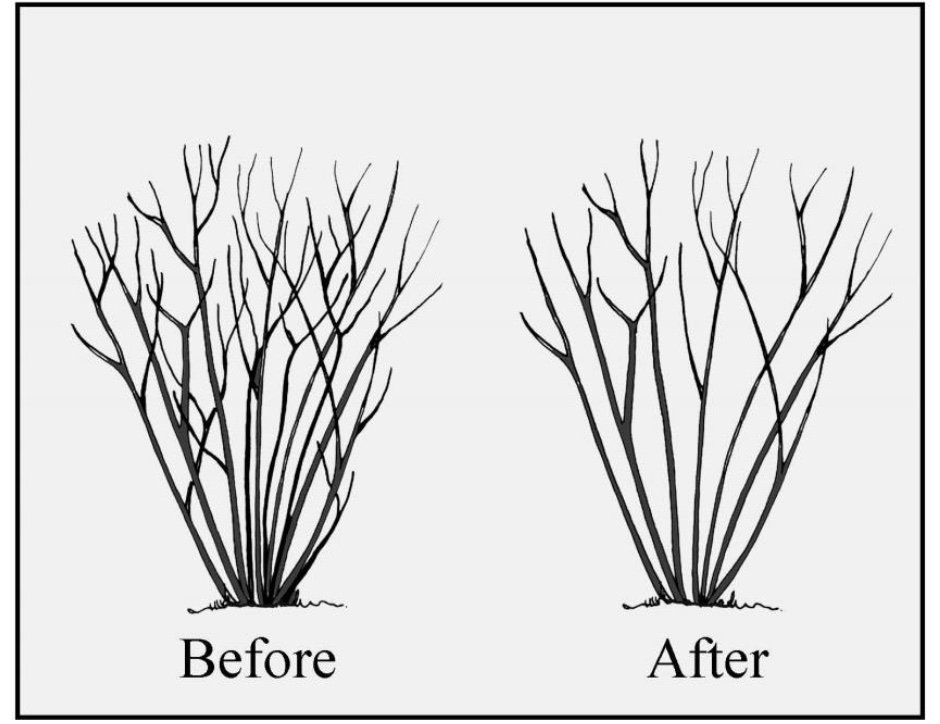
- HEADING is the process of shortening the stems. It is used to control the size and shape. Heading cuts stimulate growth on the remaining portion of the stem. To maintain the natural growth of the plant, try to avoid ‘topping’ or trimming all branches to the same level, which can lead to dense, unattractive growth at the tips of the stems. Using a combination of thinning and heading techniques will give you the best, most aesthetically pleasing results.
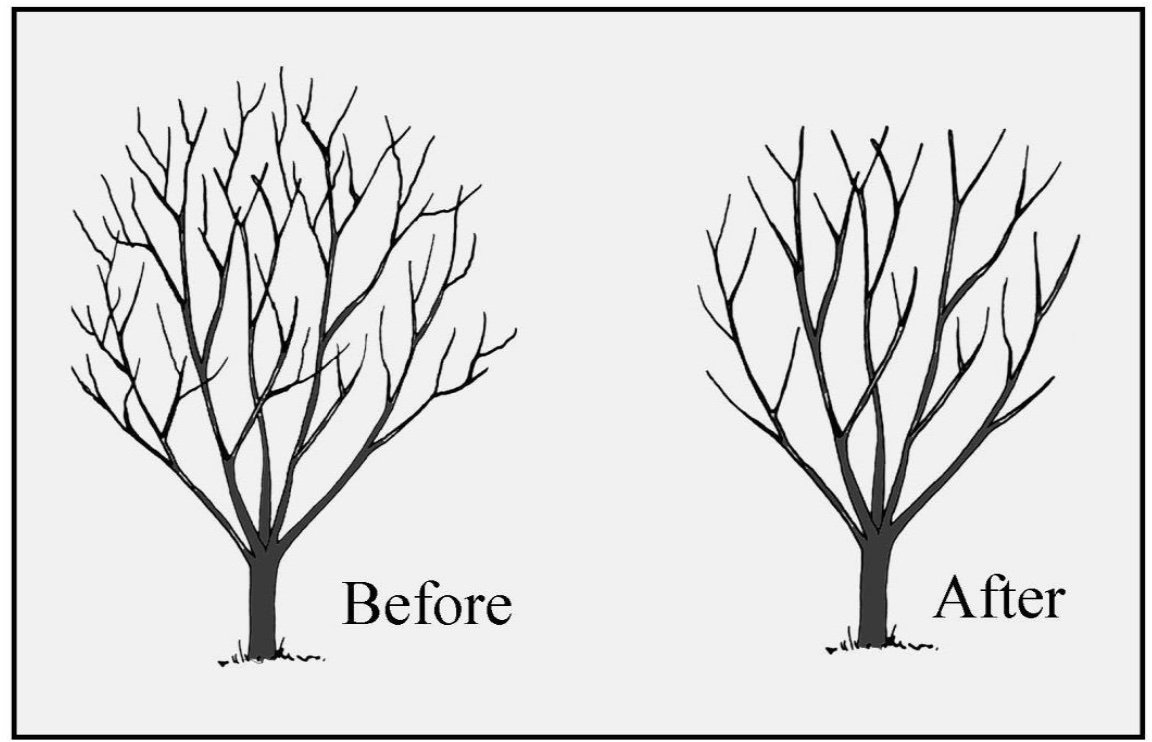
- RENEWAL PRUNING is a term commonly used to describe using thinning and heading techniques to regularly remove a portion of the older growth to encourage more vigorous new growth and better blooming. Every year or two, remove approximately 1/4 to 1/3 of the older, larger stems to the ground at the appropriate pruning time. This technique is recommended for shrubs such as viburnum and lilac.

- REJUVENATION involves more severe pruning and is generally used if a shrub is old and declining, has been neglected and/or has become quite overgrown. It should be employed when the shrub is dormant in late winter or very early spring. Cut all stems down to 6 to 12 inches in height and, if present, remove older, less productive stems completely to the crown. This allows for the possibility of new and vigorous growth during the growing season. Be aware that this technique is not appropriate for some species of shrubs, while others will come back with vigor. Do a little research before attempting this technique.
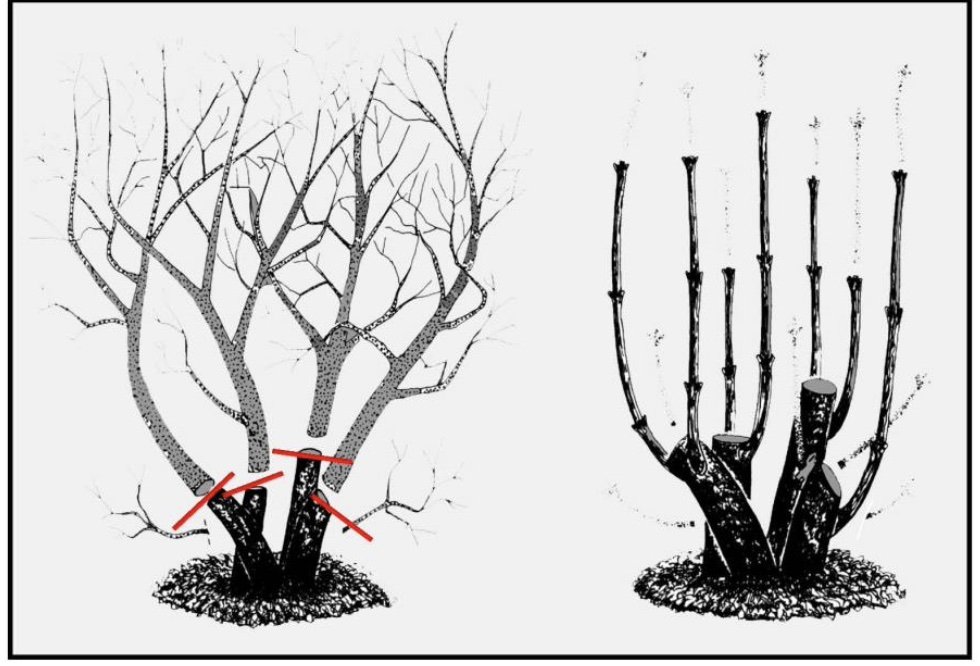
- SHEARING is a technique used to create a formal hedge or specific forms for formal gardens. Some species that tolerate shearing well include arborvitae, yew, boxwood, privet, barberry, and burning bush. Shearing involves using hand shears or electric shears to remove a few inches of growth from the tips of the branches to shape the plant and promote dense, exterior growth. The finished shape should be broadest at the bottom to retain lower foliage and rounded at the top to shed snow more easily and prevent winter damage. Because this type of pruning restricts light into the interior of the bush, disease and damage to the plant can dramatically affect the appearance of the plant. Shearing shrubs is a high maintenance endeavor that requires much more upkeep and commitment than maintaining a more natural form. Be aware of what you are getting yourself into.

WHEN SHOULD I HIRE A PROFESSIONAL?
Your home landscape is a major investment in the value of your home. Good maintenance practices will support that investment. Hiring a professional is always an option to consider whenever you feel the job may be more than you can or wish to take on. Consider using a professional for most of the care required to maintain larger trees in your landscape. For information on selecting an arborist, see Selecting a Qualified Arborist.
Maintaining your own shrubs is a more accessible endeavor for the DIY homeowner but hiring a knowledgeable professional can be well worth the investment. Whenever you plan on hiring a professional, do your research, get references and recommendations, and ask questions.
Resources
Utah State University Extension-Forestry
University of Florida-Landscape Plants
Colorado State University Extension-Master Gardeners
University of Idaho Extension-Forestry
Morton Arboretum-Pruning Deciduous Shrubs
Connecticut Agricultural Experiment Station
Photo and illustration credits (used with permission):
Photos 1-6: Edward F. Gilman, Professor, Environmental Horticulture Department, IFAS, University of Florida
Photos 7-9: Colorado State University Extension, Colorado Master Gardener GardenNotes
Photos 10-14: Connecticut Agricultural Experiment Station


